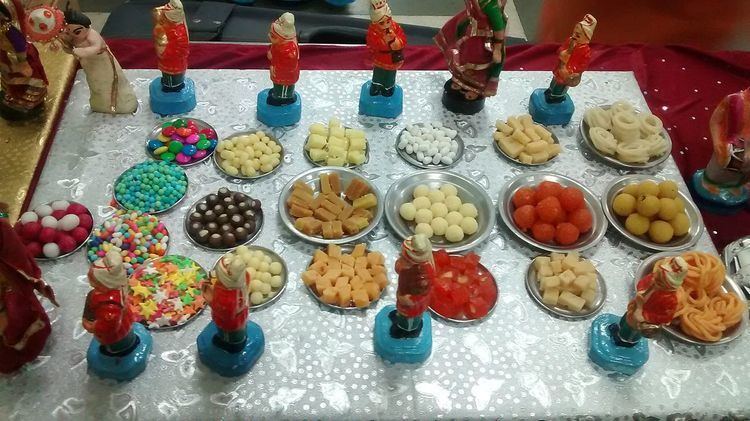 | ||
Miniature food is a kind of replica of food in a much-smaller-than-usual size. Decades before, miniature food was created like other miniature arts. In 2014, a Youtube Channel, Miniature Space, started producing videos that showcased the makings of a variety of miniature meals and dishes prepared with tiny utensils. It established a fanatical trend of miniature food in Japan, then onward toward becoming a worldwide trend. Nowadays, miniature food does not just appear as toys or accessories, but edible food as well. The process of producing the edible miniature food can be recognized as an entertainment to the creators.
Contents
History
Food models first appeared in Japan in 1917. Businesses that produced and sold these food models was set up by Iwasaki Ryuzo in 1932. In the old days, models of food were made from wax. Nowadays, they are mostly made from plastic. As the size of the sample food models showcased by the restaurants in the past were usually much larger than the actual served meals, which looks deceiving to customers. Therefore, businessmen started shrinking the size of the models. Generally delicate and tiny stuffs are called “kawaii” in Japanese, miniature food are produced with the technique of making miniature arts in Japan in the recent decades. A trend of making miniature food was brought up by a Youtubers called Miniature Space and AAAjoken. They decided to cook the tiny items with edible ingredients. More and more videos of the makings of miniature food are uploaded on Youtube thereupon. People started paying attention to the tiny creations. In 2015, a report from a video intelligence firm Tubular Labs indicated that these miniature food videos contributed up to 3% of the total views in the food category.
Edible miniature food
Miniature food can be either edible or inedible. For the edible part, materials need to be prepared for cooking processes. Real ingredients are required for cooking and food will be cooked by different miniature utensils just like tiny wok, tiny pan and long, tiny and sharp knife. Up to now, there were many successful attempts on creating different kinds of food using miniature utensils, such as strawberry cake, pancakes, and cheeseburgers. The edible miniature foods are cooked by miniature utensils which functioned as the real one, only in a much smaller size. However, regarding the appearance of the miniature food, in order to make it more realistic, sometimes the ingredients will vary from the original recipes. The food may not be cooked by any ceramic cooker.
Process
A match is used for igniting the candle to power the tiny stove. Then the food are to be cut into proper size for cooking.
Usage
The main purposes of edible miniature food is for entertaining people, be it the creators or the viewers. The chef prepares these tiny gourmet whilst the audiences would be watching the process of producing these dishes on different media. There have been many miniature food fanatics uploading cooking tutorials in their own Youtube channel over recent years.
Inedible miniature food
Inedible miniature food is food models made from inedible materials, for instance clay and resin. It is more widely and commonly seen comparing to the edible variant as it serves a wider variety of purposes, for instances jewelry, handcraft and little toys. Also, whilst ingredients are constricted in the makings of edible miniature food, there are fewer limitations in the makings of inedibles miniature food hence it opens up more possibilities in terms of what ingredients and what colouring materials are to be used. The food and the utensils are usually made of polymer clay and dry glue. The artists utilize dedicated modelling tools to mold and shape the food, sometimes utensils such as sewing needle or toothpick are also seen in the process of moldings and shapings.
Process
To produce a miniature gourmet look-alike, first choose the pre-dyed clay in the desired colour. Use your palms to soften the clay and roll the clay to the desired shape. Cook the clay in the oven, let the clay cool down in the oven until it is cool enough to be handled again. After it is cooled, take the razor blade and shave off a tiny pile of white powder from chalk. Spray or paint a layer of Varathane sealer. While the sealer is still wet, pick up some of the white chalk powder with your finger tip and dab it sparingly onto a few areas of the clay. The general shape of the model is thereby finished. Lastly, one may utilize different paints and colouring tools to finish the process.
Usage
People purchase these tiny creations to decorate their households or workplaces. Some buy miniature foods as presents to others. Fanatics see miniature food as collectible and cherishable gems.
Artists
Tomo Tanaka, who lives in Osaka, makes items in 1:12 or 1:24 scale for display. He also crafted cookwares, glasses and samurai swords.
Miniature Space, a Youtube Channel, uploads videos of making miniature meals with genuine ingredients, such as quail eggs, chickens, fishes.
Shay Aaron, who is a miniature food jewelry artist, makes his jewelry collections with polymer clay Fimo and other materials such as metals and paper in 1:12 scale.
